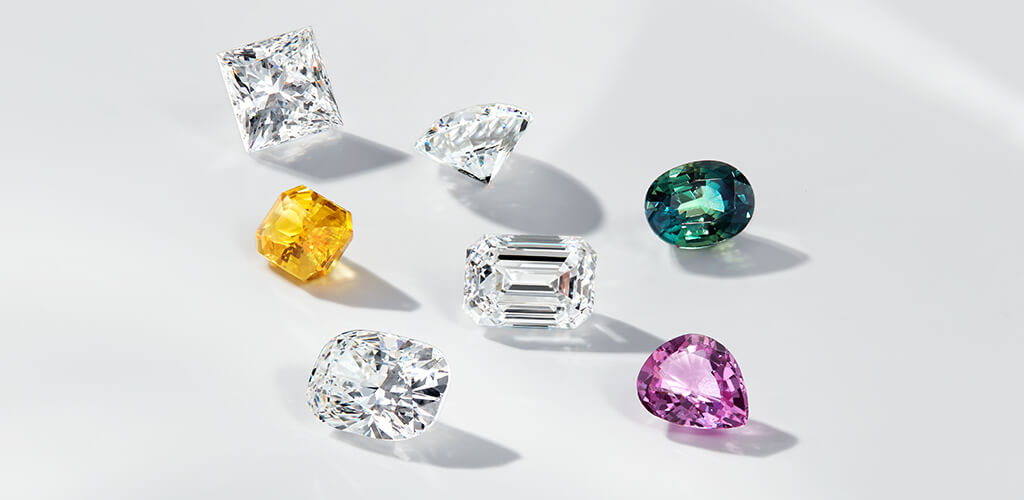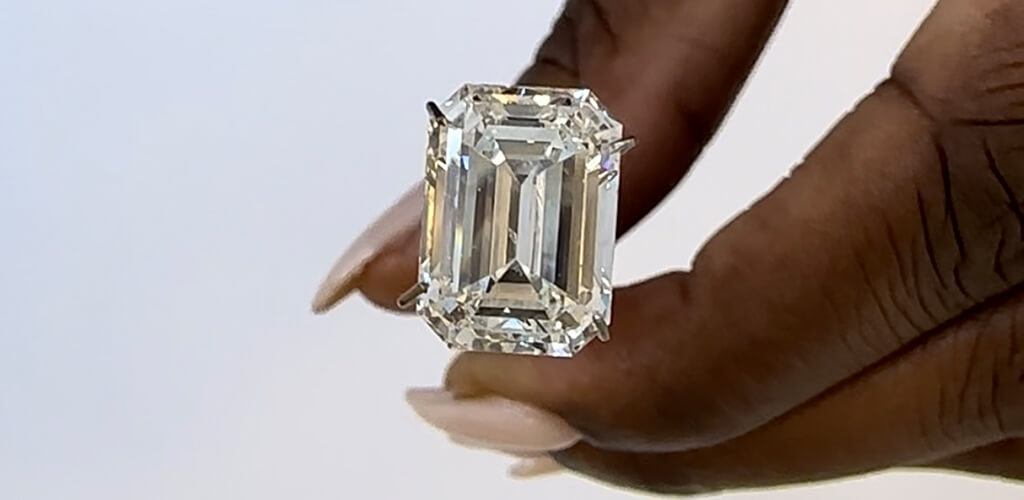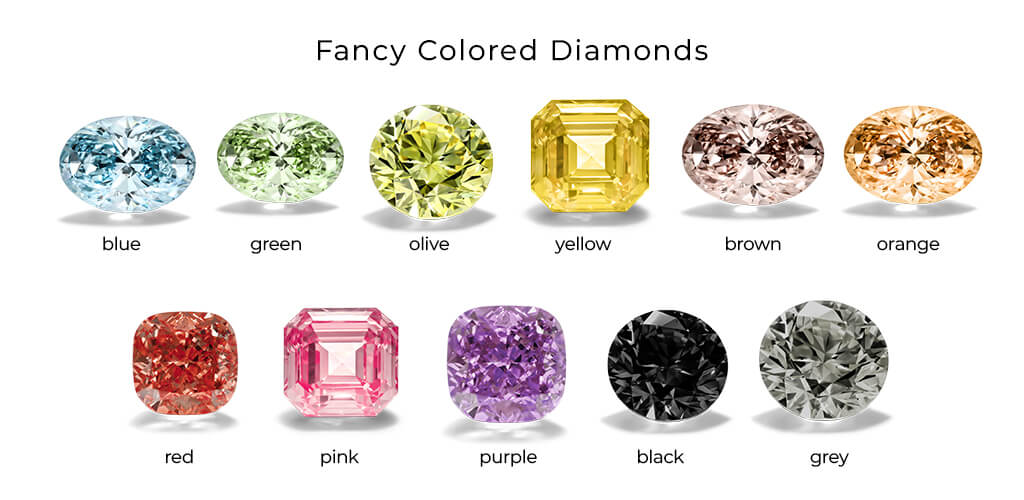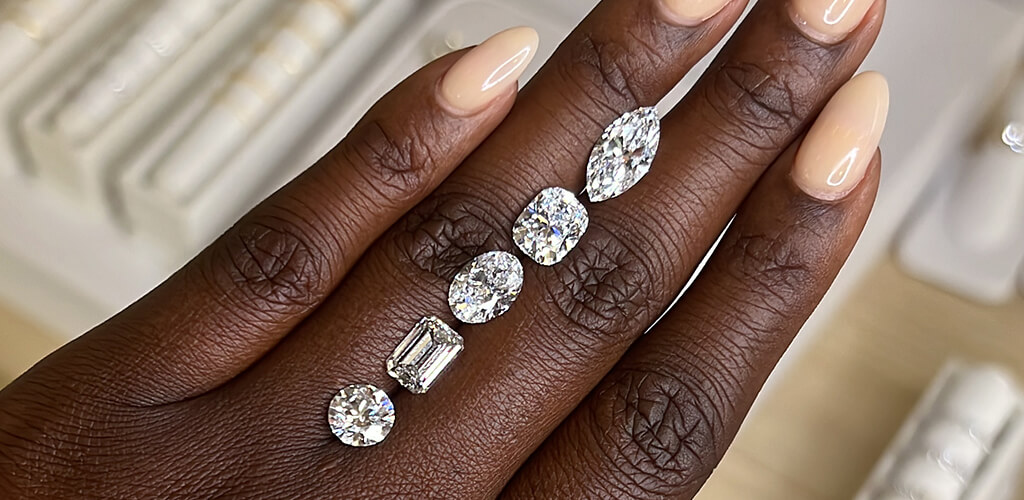
Diamonds, we love to wear them, but how much do we know about these stunning gems? Whether you are shopping for an engagement ring or simply fascinated by these sparkling gems, understanding diamond colors and colored diamonds is essential.
Diamond color refers to the natural hue of a diamond, which can range from completely colorless to various shades of yellow or brown. The color of a diamond significantly impacts its appearance and value.
To standardize the assessment of diamond color, the Gemological Institute of America (GIA) established a color grading scale ranging from D (colorless) to Z (light yellow or brown).

Diamonds in the D-F range are considered completely colorless. These diamonds are exceptionally rare and highly prized for their pure, icy appearance. When viewed under proper lighting, they exhibit no detectable color, making them appear brilliantly white.
Popularity and Value:
Colorless diamonds are the most sought-after due to their rarity and breathtaking brilliance. They tend to command higher prices compared to diamonds with noticeable color. These diamonds are perfect for those seeking the ultimate in diamond quality.
Diamonds in the G-J range are nearly colorless, with only slight traces of color that are difficult to detect unless compared side by side with higher color grades. These diamonds offer an excellent balance of beauty and value.
Best Settings for Near-Colorless Diamonds:
Near-colorless diamonds look stunning in a variety of settings, but they are particularly striking in white gold or platinum, which enhances their almost colorless nature.
Diamonds graded K-M show a faint yellow tint that is more noticeable than in higher grades. These diamonds are often chosen for their affordability and can still exhibit significant brilliance and sparkle.
When to Choose Faint Yellow Diamonds:
Faint yellow diamonds are a great option for those looking to maximize size and quality while staying within a budget. They pair beautifully with yellow gold settings, which can make the faint yellow tint less noticeable.
Diamonds in the N-R range have a more noticeable yellow tint, but they can still be quite beautiful. The yellow color is more apparent to the naked eye, especially in larger stones.
Pros and Cons:
These diamonds are more affordable than higher color grades, making them accessible for many buyers. However, the yellow tint may not appeal to everyone and can affect the diamond’s overall brilliance.
Characteristics of Light Yellow Diamonds:
Diamonds graded S-Z have a strong yellow or brown tint. These diamonds are often used in jewelry that emphasizes unique, warm tones.
Pricing and Considerations
Light yellow diamonds are the most affordable on the GIA color scale. They are ideal for those who appreciate the warmth of a colored diamond and are looking for a distinctive piece of jewelry.

Fancy color diamonds and colored diamonds are those that exhibit intense color beyond the Z grade. They come in a rainbow of hues, including blue, green, pink, and even red. These diamonds are graded on a separate scale that considers the intensity and distribution of color.
Fancy color diamonds are rare and highly collectable. Their unique colors are often due to trace elements or structural irregularities within the diamond. Because of their rarity, they can be significantly more expensive than colorless diamonds.
Fact: The color of blue diamonds is caused by the presence of boron. The Hope Diamond is one of the most famous blue diamonds in the world.
Fact: Green diamonds get their color from exposure to natural radiation over millions of years. The Dresden Green is a well-known example.
Fact: The exact cause of pink diamonds’ color is still a mystery, but it is believed to be due to structural distortions. Pink diamonds are highly sought after, with the Pink Star being one of the most famous.
Fact: Yellow diamonds, also known as canary diamonds, get their vibrant color from nitrogen impurities. The Tiffany Yellow Diamond is a renowned example.
Fact: Red diamonds are the rarest of all fancy colors. They owe their color to a unique atomic structure. The Moussaieff Red is one of the largest known red diamonds.
Fact: Orange diamonds are very rare and get their color from a combination of nitrogen and structural defects. The Pumpkin Diamond is a famous orange diamond.
Fact: Purple diamonds are believed to get their color from a high concentration of hydrogen. The Royal Purple Heart Diamond is a notable example.
Fact: Brown diamonds, also known as champagne or cognac diamonds, are the most common fancy color. They get their color from internal grain structure distortions.
Fact: Black diamonds, also known as carbonado, are primarily composed of graphite and amorphous carbon, giving them their dark appearance. The Black Orlov is a famous black diamond.
Fact: Gray diamonds get their color from a high presence of hydrogen or boron. They are often marketed as “charcoal” or “steel” diamonds.

Choosing the right diamond color depends largely on personal taste and budget. Some may prefer the classic look of a colorless diamond, while others might be drawn to the unique charm of a faint yellow or fancy color diamond.
The color of the metal setting can either enhance or diminish the appearance of the diamond’s color. White metals like platinum and white gold complement colorless and near-colorless diamonds, while yellow and rose gold can enhance the warm tones of faint yellow and light yellow diamonds.
The color of a diamond can affect its brilliance and sparkle. Colorless diamonds allow more light to pass through, resulting in greater brilliance. Diamonds with more color can absorb light, which may reduce their sparkle.
Some diamonds exhibit fluorescence, which can affect their color. In certain lighting conditions, fluorescent diamonds may appear to have a different hue. This can either enhance or detract from the diamond’s appearance, depending on the intensity and color of the fluorescence.
To accurately assess a diamond’s color, it should be viewed under natural daylight or a daylight-equivalent light source. This helps to reveal the true color without the influence of artificial lighting.
A diamond color grading chart can be a helpful tool for comparing different diamonds. By placing diamonds next to each other and using the chart as a reference, you can better understand their color differences.
Always look for diamonds that come with a certification from a reputable gemological laboratory, such as the GIA. This ensures that the diamond’s color grade is accurately assessed.
When shopping for diamonds, it’s beneficial to compare multiple stones side by side. This allows you to see subtle differences in color and choose the diamond that best fits your preferences.

Understanding diamond color and the nuances of colored diamonds is essential for making an informed purchase. From the icy brilliance of colorless diamonds to the vibrant hues of fancy color diamonds, each stone offers its own unique charm and value. Whether you’re drawn to the classic look of a colorless diamond or the distinct beauty of a colored diamond, knowing the factors that influence diamond color will help you choose the perfect gem.
Colorless diamonds (D-F) are the most popular due to their rarity and brilliant appearance.
Diamond color significantly affects price, with colorless diamonds (D-F) being more expensive than diamonds with noticeable color.
Diamond color cannot be permanently changed, but certain treatments can enhance the appearance of color in some diamonds.
The rarest diamond colors are red and blue, with green and pink diamonds also being exceptionally rare.
Both color and clarity are important, but personal preference often dictates which characteristic is prioritized. Some may value a higher color grade, while others may prioritize clarity.